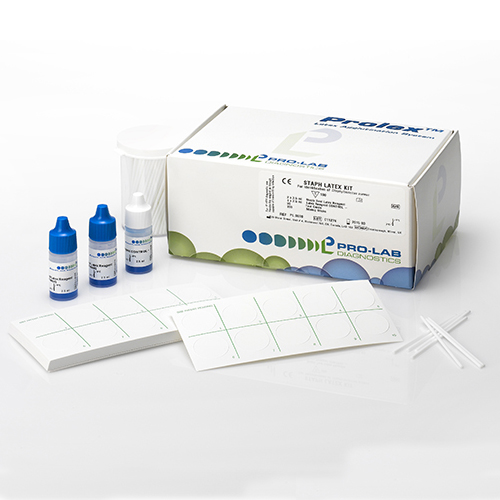Staphylococcus
DiaMondial Staph Plus Latex Kit
The kit provides a rapid method to distinguish staphylococci (particularly staphylococus aureus) and methicillin-resistant S. aureus (MRSA) from other species of staphylococci in cultured specimens.
Principle of the test
DiaMondial Staph Plus Latex Kit utilizes polystyrene latex particles which have been sensitized with fibrinogen and IgG that are specific for capsular types 5 and 8 of S. aureus. When Staphylococcal colonies which possess at least one of clumping factor, protein A and / or capsular 5 or 8 antigens are mixed with the latex reagent, the latex particles agglutinate strongly within 20 seconds.
Features:
• As few as 2 colonies required from primary culture
• Enhanced results with blue carboxylated microparticles (CM-MP)
• Detects all Staphylococcus aureus including MRSA
• Detects Coagulase, Protein A and Capsular Polysaccharide 5 and 8 Antigens
• Definitive results obtained within 20 seconds
• High performance (sensitivity of 100% and specificity of 100%)
Product list
| Cat. Num. | Product | Pack |
| DML 1100 | Staph Latex kit | 100 tests |
| DML 1130 | Staph Latex kit | 300 tests |
DiamondiaL Staph Plus, 4th generation
The first 4th Generation Latex Kit for Staphylococcus aureus including MRSA.
Product features:
– Enhanced results with blue carboxylated microplates (CM-MP)
– Detects Coagulase, Protein A
– Detects Capsular Polysaccharide 5 and 8
– Definitive results obtained within 20 seconds
– High performance with sensitivity of 100% and specifity of 100%
– Contains negative control
– 100 test kit
– Blue latex
– White reaction cards
Coagulase Plasma
• 10 X 2 ml vial
• 10 X 5 ml vial
• 10 ml vial
• 20 ml vial
• 30 ml vial
Coagulase test
The enzyme coagulase, produced by a few of the Staphylococcus species, is a key feature of pathogenic Staph. The enzyme produces coagulation of blood, allowing the organism to “wall ” its infection off from the host’s protective mechanisms rather effectively.
There are 2 methods: slide test and tube test. The tube test is more accurate, but the slide test is faster. If you have a Staph unknown, you might consider running the slide test, and, if negative, running the tube test. The tube method is THE definitive test.
Objectives
Identify the presence of the enzyme coagulase.
Materials needed
0.5 ml rabbit plasma per unknown
The procedure
Pathogenic Staph species (e.g. Staph aureus) can be confirmed using the coagulase test. Since there are 2 kinds of coagulase enzyme—bound and free—there are 2 different tests that can be used to identify these enzymes. Both of the enzymes activate fibrinogen in plasma, in different ways.
Slide Agglutination test
Make a 2,54 cm diameter circle on a clean glass slide using a wax pencil. Place two drops of thawed rabbit plasma into the circle, using a wooden pick or a clean loop. Add a single colony and emulsify it in the plasma. Add a single colony and emulsify it in the plasma. Fibrin threads form between the cells, causing them to agglutinate, or clump. There will a visible clumping of cells within 10-15 seconds. This test is for the bound coagulase enzyme.
Tube Agglutination test
Inoculate a tube with a 0,5 ml of rabbit plasma with the bacterial inoculum. Place at 37 °C and check at 0,5 hour and after (some strains will give a + reaction in a few hours, other strains take longer) by tipping the slide at an angle. Any degree of coagulation is considered a positive test for the free coagulase enzyme. Add a single colony and emulsify it in the plasma. Fibrin threads form between the cells, causing them to agglutinate, or clump. There will a visible clumping of cells within 10-15 seconds. This test is for the bound coagulase enzyme.
Please contact us if you need a specific product, we are meeting many customers’ unique requests.
